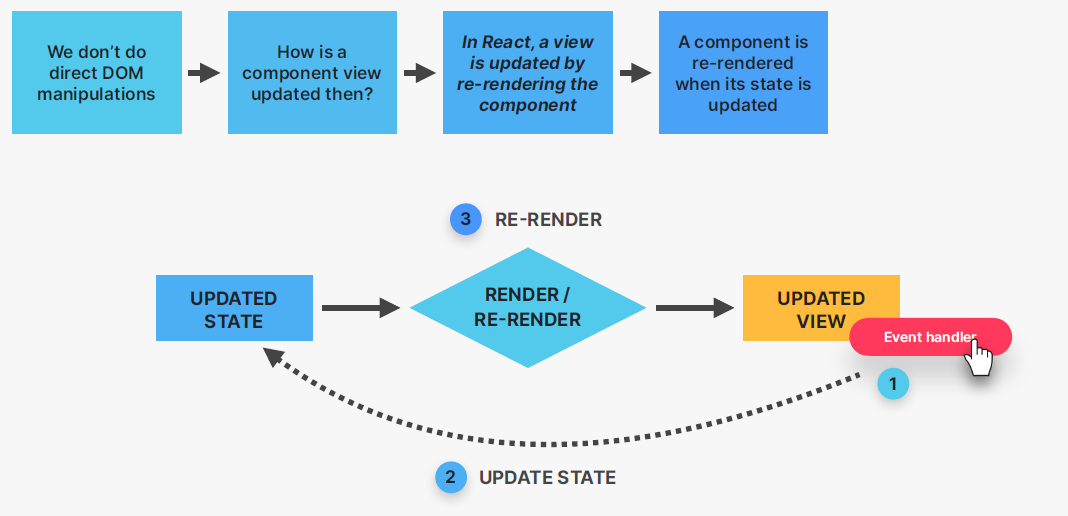What is state
Data that a component can hold over time, necessary for information that it needs to remember throughout the app’s lifecycle
- component’s “memory”
- most important concept in react
- It updates the components view (by re-rendering it) - it’s how react makes the UI in sync with data
- State is internal data that can be updated by the component’s logic
- Updating component state triggers React to re-render the component!!
- user can easily modify these values
- most important tool in react!!
- example
- notification count, text content of input field, active tab in a tab component
- content of shopping cart
- allows devs to persist local variables between renders
- terms
- state variable/piece of state
- a single variable in a component (component state)
- the term state itself
- refers to the entire state that the component is in, like the entire condition at a certain point in time
- component view
- the component visually rendered on the UI
- view
- a single component being rendered
- all views combined together make up the final user interface
- state variable/piece of state
How to use state in practice
- state should be top level (ex. if shouldn’t be in an if else or a function)
- never manually update state, but always use the setter function!!!
- always treat state as immutable, something u can’t change directly but only through the tools react gives you
useStateis a hook, all hooks begin withuse- sample code
❌ INCORRECT!!!
export default function App() {
const [step, setStep] = useState(1);
function handlePrevious() {
if (step > 1) setStep(step - 1);
}
function handleNext() {
if (step < 3) setStep(step + 1);
}
...
<p className="message">
Step {step}: {messages[step - 1]}
</p>
<div className="buttons">
<button
style={{ backgroundColor: "#7950f2", color: "#fff" }}
onClick={handlePrevious}
>
Previous
</button>
<button
style={{ backgroundColor: "#7950f2", color: "#fff" }}
onClick={handleNext}
>
Next
</button>
...- React batches state updates, so if you call
setStep(step + 1);multiple times in a row, it may not update as expected because count might be stale.
✅ The correct way
function handlePrevious() {
if (step > 1) setStep((step) => step - 1);
}
function handleNext() {
if (step < 3) setStep((step) => step + 1);
}
function handleOpen() {
setIsOpen((isOpen) => !isOpen);
}- We should pass in a callback function: If your new state depends on the previous state, use the function form:
setState(prevState => newState)- receives current value of the state
- BUT if the new state does not depend on the previous state, you can pass the new value directly
Mechanics of state
- Remember: we don’t manipulate the DOM directly when when we want to update a component’s view (it’s declarative, not imperative).
- React preserves the component state throughout re-renders. When state is updated, component is automatically re-rendered.
- every time it’s re-rendered, the component function is called again
- (actually not the whole thing is rendered, but only the parts that need to change, something we’ll learn later)
- So, whenever we want to update a component view, we update its state!
- And React will “react” to that update by re-rendering the user interface

- And React will “react” to that update by re-rendering the user interface
Each component has and manages its own state, no matter how many times we render the same component
- You could think of the entire application view (entire UI) as a function of state
- the entire UI is always a representation of all the current states in all components
- We view UI as a reflection of data changing over time
Practical guidelines
